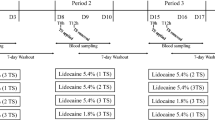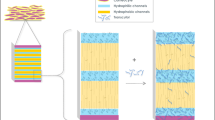Abstract
Purpose. The aim of the current investigation was to evaluate the percutaneous absorption of the synthetic cannabinoid WIN 55,212-2 in vitro and in vivo.
Methods. The in vitro permeation studies of WIN 55,212-2 in human skin, hairless guinea pig skin, a polymer membrane with adhesive, and a skin/polymer membrane composite were conducted in flow-through diffusion cells. The pharmacokinetic parameters for WIN 55,212-2 were determined after intravenous administration and topical application of Hill Top Chambers and transdermal therapeutic systems (TTS) in guinea pigs.
Results. The in vitro permeation studies indicated that the flux of WIN 55,212-2 through hairless guinea pig skin was 1.2 times more than that through human skin. The flux of WIN 55,212-2 through human and guinea pig skin was not significantly higher than that through the corresponding skin/polymer membrane composites. The mean guinea pig steady-state plasma concentrations after topical 6.3 cm2 chamber and 14.5 cm2 TTS patch applications were 5.0 ng/ml and 8.6 ng/ml, respectively.
Conclusions. The topical drug treatments provided significant steady-state plasma drug levels for 48 h. The observed in vivo results from the Hill Top Chambers and TTS patches in the guinea pigs were in good agreement with the predicted plasma concentrations from the in vitro data.
Similar content being viewed by others
References
J. E. Joy, S. J. Watson, and J. A. Benson. Marijuana and Medicine, National Academy Press, Washington, DC, 1999.
N. A. Darmani. Antiemetic action of Δ9-tetrahydrocannabinol and synthetic cannabinoids in chemotherapy-induced nausea and vomiting. In E. S. Onaivi (ed.), Biology of Marijuana: From Gene to Behavior, Taylor and Francis, London, 2001, pp. 356-389.
A. S. Abrahamov, A. Abrahamov, and R. Mechoulam. An efficient new cannabinoid antiemetic in pediatric oncology. Life Sci. 56:2097-2102 (1995).
H. S. L. Chan, J. A. Correia, and S. M. Macleod. Nabilone versus prochlorperazine for control of cancer chemotherapy-induced emesis in children: A double blind, crossover trial. Pediatrics 79:946-952 (1987).
A. M. Dalzell, H. Bartlett, and J. S. Lilleyman. Nabilone: an alternative antiemetic for cancer chemotherapy. Arch. Disease Childhood 161:502-505 (1986).
N. A. Darmani. Δ9-Tetrahydrocannabinol prevents chemotherapy-induced vomiting via activation of cannabinoid CB1 receptors. Soc. Neurosci. Abs 26:P2160(2000).
N. A. Darmani. Δ9-Tetrahydrocannabinol and synthetic cannabinoids prevent emesis produced by the cannabinoid CB1 receptor antagonist/inverse Agonist SR 141716A. Neuropsychopharmacology 24:198-203 (2001).
M. Rinaldi-Carmona, F. Barth, M. Heaume, D. Shire, B. Calandra, C. Congy, S. Marinez, J. Maruni, G. Neliat, D. Caput, P. Ferrara, P. Soubrie, J. C. Breliere, and G. LeFur. SR14716A, a potent and selective antagonist of the brain cannabinoid receptor. FEBS Lett. 350:240-244 (1994).
R. G. Pertwee. Pharmacology of cannabinoid CB1 and CB2 receptors. Pharmacol. Therap 74:129-180 (1997).
J. Li, R. S. Daughters, C. Bullis, R. Bengiamin, M. W. Stucky, J. Brennan, and D. A. Simone. The cannabinoid receptor agonist WIN 55, 212-2 mesylate blocks the development of hyperalgesia produced by capsaicin in rats. Pain 81:25-33 (1999).
O. Yesilyurt, A. Dogrul, H. Gul, M. Seyrek, O. Kusmez, Y. Ozkan, and O. Yildiz. Topical cannabinoid enhances morphine antinociception. Pain (2003).
Q. Zhang, P. Ma, M. Isard, R. B. Cole, W. Wang, and G. Wang. In vitro metabolism of R(±)-[2,3-dihydro-5-methyl-3-[(morpholinyl)methyl] pyrrolo [1,2,3-de] 1,4-benzoxazinyl]-(1-naphthalenyl) methanone mesylate, A cannabinoid receptor agonist. Drug Metab. Disp. 30:1077-1086 (2002).
E. Touitou, B. Fabin, S. Dany, and S. Almog. Transdermal delivery of tetrahydrocannabinol. Int. J. Pharm. 43:9-15 (1988).
E. Touitou and B. Fabin. Altered skin permeation of a highly lipophilic molecule: tetrahydrocannabinol. Int. J. Pharm. 43:17-22 (1988).
B. Fabin and E. Touitou. Localization of lipophilic molecules penetrating rat skin in vivo by quantitative autoradiography. Int. J. Pharm. 74:59-65 (1991).
P. V. N. Challapalli and A. L. Stinchcomb. In vitro experiment optimization for measuring tetrahydrocannabinol skin permeation. Int. J. Pharm. 241:329-339 (2002).
R. H. Guy and J. Hadgraft. The prediction of plasma levels of drugs following transdermal application. J. Controlled Release 1:177-182 (1985).
R. H. Guy. and J. Hadgraft. Interpretation and prediction of the kinetics of transdermal drug delivery: oestradiol, hyoscine and timolol. Int. J. Pharm. 32:159-163 (1986).
G. L. Flynn, V. P. Shah, S. N. Tenjarla, M. Corbo, D. DeMagistris, T. G. Feldman, T. G. Franz, D. R. Miran, D. M. Pearce, J. A. Sequeira, J. Swarbrick, J. C. Wang, A. Yacobi, and J. L. Zatz. Assessment of value and applications of in vitro testing of topical dermatological drug products. Pharm. Res. 16:1325-1330 (1999).
V. P. Shah, C. R. Behl, G. L. Flynn, W. I. Higuchi, and H. Shaefer. Principles and criteria in the development and optimization of topical therapeutic products. Pharm. Res. 9:1107-1111 (1992).
S. Kumar, H. Char, S. Patel, D. Piemonstese, K. Iqbal, A. W. Malick, E. Neugroschel, and C. R. Behl. Effect of iontophoresis on in vitro skin permeation of an analogue of growth hormone releasing factor in the hairless guinea pig model. J. Pharm. Sci. 81:635-639 (1992).
K. C. Moon, R. C. Wester, and H. I. Maibach. Diseased skin models in the hairless guinea pig skin: In vivo percutaneous absorption. Dermatologica 180:8-12 (1999).
R. Panchagnula, K. Stemmer, and W. A. Ritschel. Animal models for transdermal drug delivery. Methods Find. Exp. Clin. Pharmacol. 19:335-341 (1997).
H. Sueki, C. Gammak, K. Kudoh, and A. M. Kligman. Hairless guinea pig skin: Anatomical basis for studies of cutaneous biology. Eur. J. Dermatol. 10:357-364 (2000).
J. K. Knapczyk and R. H. M. Simon. In J. A. Kent (ed.), Riegel's Industrial Chemistry, VNR, New York, 1992, pp. 640.
Y. N. Kalia and R. H. Guy. Modeling transdermal drug release. Adv. Drug Deliv. Rev. 48:159-172 (2001).
R. H. Guy. and J. Hadgraft. Rate control in transdermal delivery? Int. J. Pharm. 82:R1-R6 (1992).
G. Imanidis, W. Q. Song, P. H. Lee, M. H. Su, E. R. Kern, and W. I. Higuchi. Estimation of skin target site acyclovir concentrations following controlled (Trans) dermal drug delivery in topical and systemic treatment of cutaneous HSV-1 infections in hairless mice. Pharm. Res. 11:1035-1041 (1994).
Author information
Authors and Affiliations
Corresponding author
Rights and permissions
About this article
Cite this article
Valiveti, S., Hammell, D.C., Earles, D.C. et al. Transdermal Delivery of the Synthetic Cannabinoid WIN 55,212-2: In Vitro/in Vivo Correlation. Pharm Res 21, 1137–1145 (2004). https://doi.org/10.1023/B:PHAM.0000032999.31948.2e
Issue Date:
DOI: https://doi.org/10.1023/B:PHAM.0000032999.31948.2e




